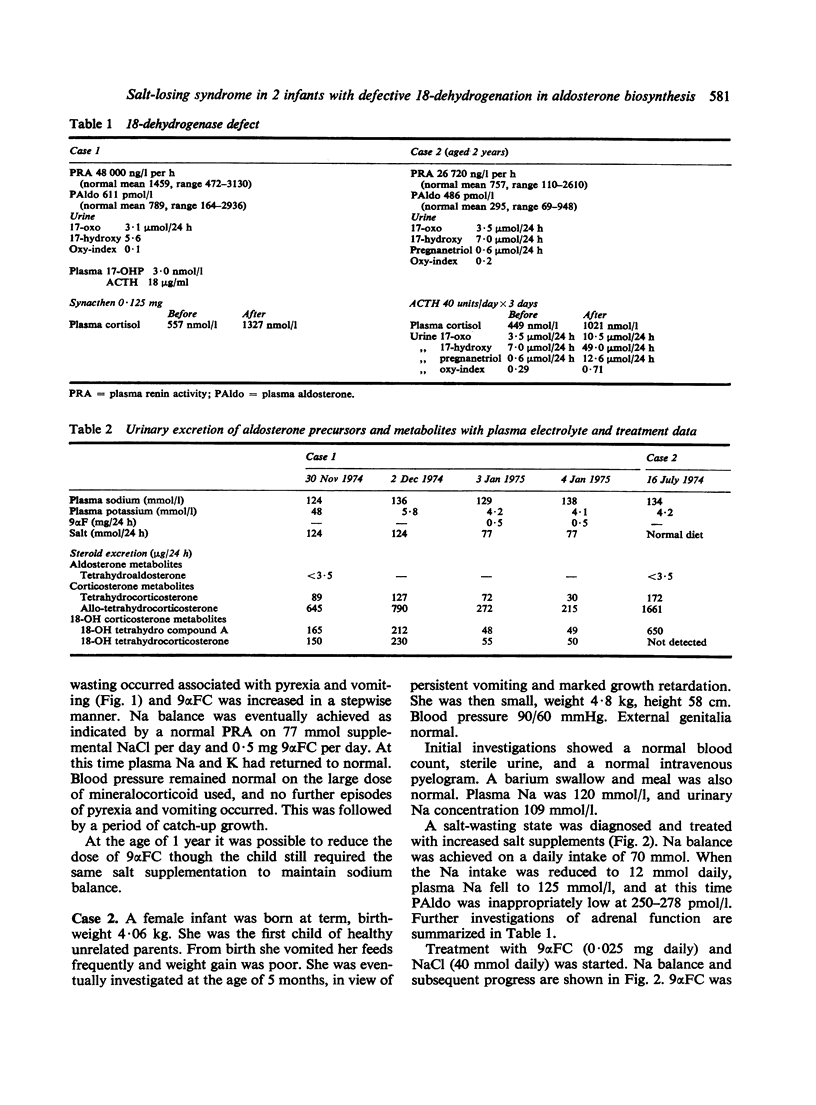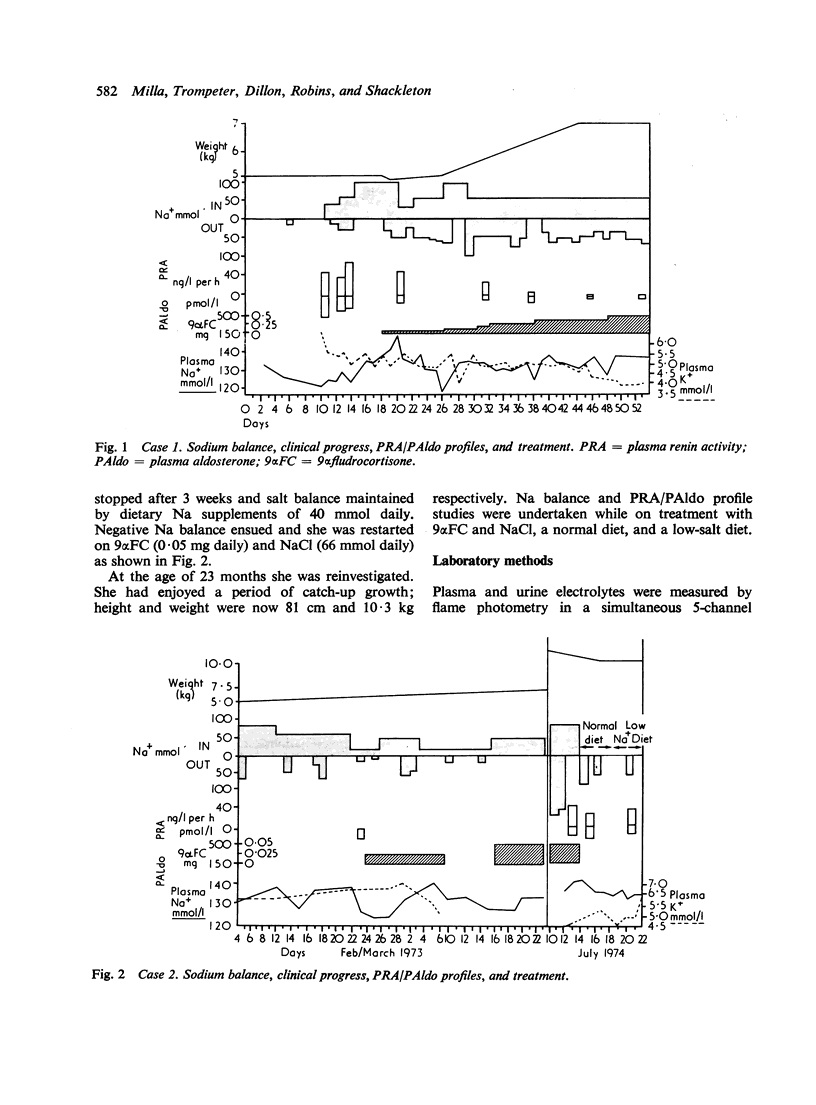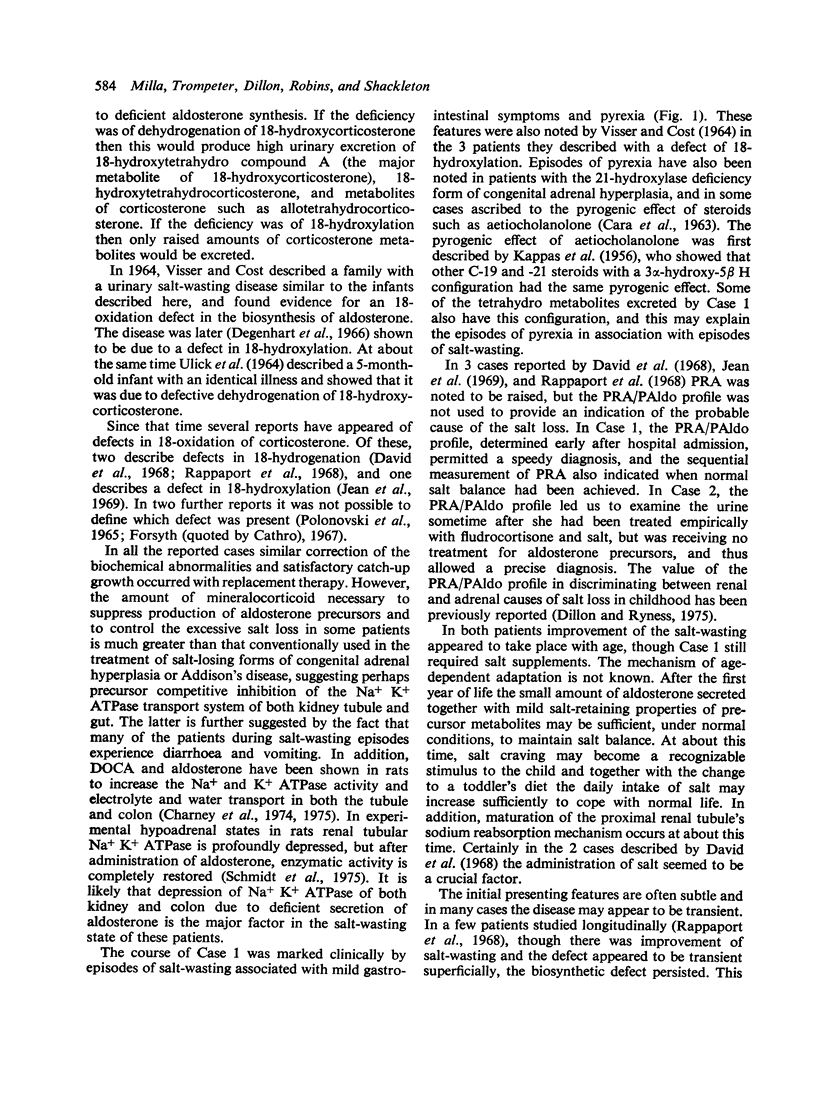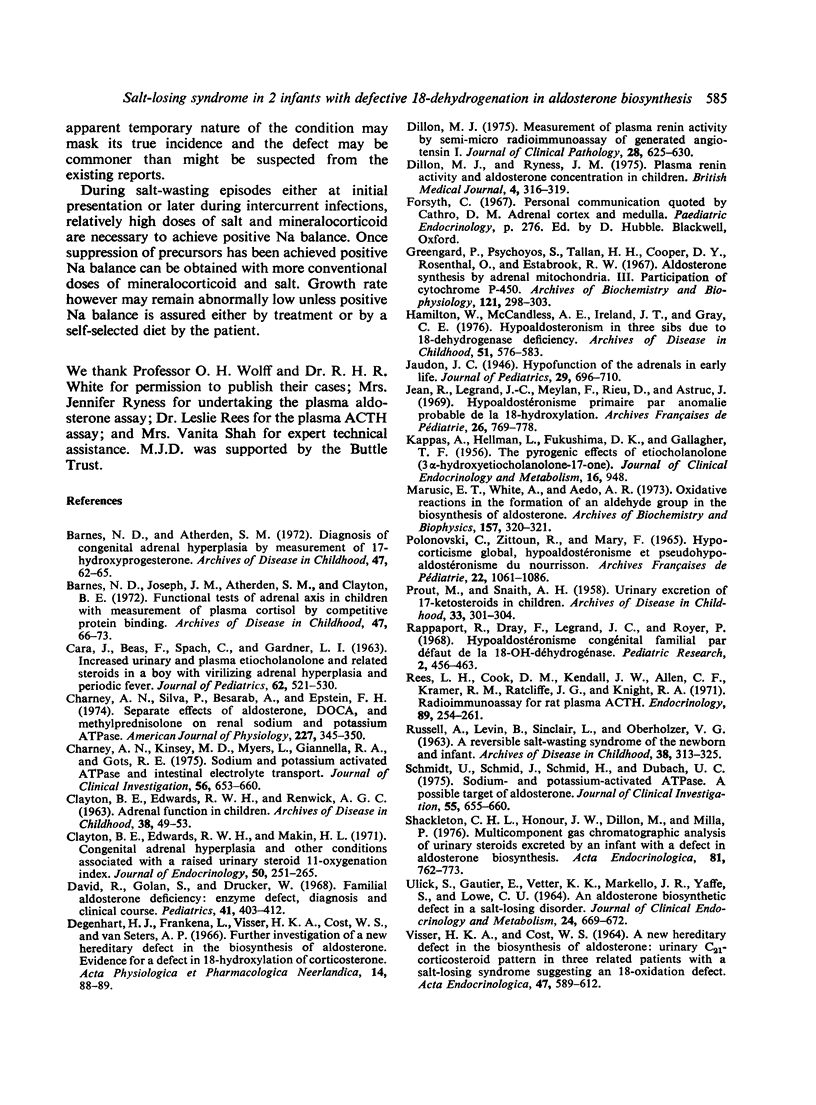Abstract
Two infants presented with a salt-losing syndrome, the presenting features of which were subtle. One case appeared to be transient. Deficient production of aldosterone was shown by plasma renin activity and plasma aldosterone profile. Gas chromatography-mass spectrometry of urine indicated a defect in 18-dehydrogenation of 18-hydroxycorticosterone. Treatment with salt supplements and 9alpha-fludrocortisone reversed the salt-losing state and in one case treatment was later stopped. Although the disease may appear transient, the biochemical defect is persistent and for adequate growth a positive salt-balance is necessary.
Full text
PDF






Selected References
These references are in PubMed. This may not be the complete list of references from this article.
- Barnes N. D., Atherden S. M. Diagnosis of congenital adrenal hyperplasia by measurement of plasma 17-hydroxyprogesterone. Arch Dis Child. 1972 Feb;47(251):62–65. doi: 10.1136/adc.47.251.62. [DOI] [PMC free article] [PubMed] [Google Scholar]
- Barnes N. D., Joseph J. M., Atherden S. M., Clayton B. E. Functional tests of adrenal axis in children with measurement of plasma cortisol by competitive protein binding. Arch Dis Child. 1972 Feb;47(251):66–73. doi: 10.1136/adc.47.251.66. [DOI] [PMC free article] [PubMed] [Google Scholar]
- CARA J., BEAS F., SPACH C., GARDNER L. I. Increased urinary and plasma etiocholanolone and related steroids in a boy with virilizing adrenal hyperplasia and periodic fever. J Pediatr. 1963 Apr;62:521–530. doi: 10.1016/s0022-3476(63)80009-8. [DOI] [PubMed] [Google Scholar]
- CLAYTON B. E., EDWARDS R. W., RENWICK A. G. Adrenal function in children. Arch Dis Child. 1963 Feb;38:49–53. doi: 10.1136/adc.38.197.49. [DOI] [PMC free article] [PubMed] [Google Scholar]
- Charney A. N., Kinsey M. D., Myers L., Gainnella R. A., Gots R. E. Na+-K+-activated adenosine triphosphatase and intestinal electrolyte transport. Effect of adrenal steroids. J Clin Invest. 1975 Sep;56(3):653–660. doi: 10.1172/JCI108135. [DOI] [PMC free article] [PubMed] [Google Scholar]
- Charney A. N., Silva P., Besarab A., Epstein F. H. Separate effects of aldosterone, DOCA, and methylprednisolone on renal Na-K-ATPase,. Am J Physiol. 1974 Aug;227(2):345–350. doi: 10.1152/ajplegacy.1974.227.2.345. [DOI] [PubMed] [Google Scholar]
- Clayton B. E., Edwards R. W., Makin H. L. Congenital adrenal hyperplasia and other conditions associated with a raised urinary steroid 11-oxygenation index. J Endocrinol. 1971 Jun;50(2):251–265. doi: 10.1677/joe.0.0500251. [DOI] [PubMed] [Google Scholar]
- David R., Golan S., Drucker W. Familial aldosterone deficiency: enzyme defect, diagnosis, and clinical course. Pediatrics. 1968 Feb;41(2):403–412. [PubMed] [Google Scholar]
- Dillon M. J. Measurement of plasma renin activity by semi-micro radioimmunoassay of generated angiotensin I. J Clin Pathol. 1975 Aug;28(8):625–630. doi: 10.1136/jcp.28.8.625. [DOI] [PMC free article] [PubMed] [Google Scholar]
- Dillon M. J., Ryness J. M. Plasma renin activity and aldosterone concentration in children. Br Med J. 1975 Nov 8;4(5992):316–319. doi: 10.1136/bmj.4.5992.316. [DOI] [PMC free article] [PubMed] [Google Scholar]
- Greengard P., Psychoyos S., Tallan H. H., Cooper D. Y., Rosenthal O., Estabrook R. W. Aldosterone synthesis by adrenal mitochondria. 3. Participation of cytochrome P-450. Arch Biochem Biophys. 1967 Aug;121(2):298–303. doi: 10.1016/0003-9861(67)90079-3. [DOI] [PubMed] [Google Scholar]
- Hamilton W., McCandless A. E., Ireland J. T., Gray C. E. Hypoaldosteronism in three sibs due to 18-dehydrogenase deficiency. Arch Dis Child. 1976 Aug;51(8):576–583. doi: 10.1136/adc.51.8.576. [DOI] [PMC free article] [PubMed] [Google Scholar]
- Jean R., Legrand J. C., Meylan F., Rieu D., Astruc J. Hypoaldostéronisme primaire par anomalie probable de la 18-hydroxylation. Arch Fr Pediatr. 1969 Aug-Sep;26(7):769–777. [PubMed] [Google Scholar]
- Marusic E. T., White A., Aedo A. R. Oxidative reactions in the formation of an aldehyde group in the biosynthesis of aldosterone. Arch Biochem Biophys. 1973 Jul;157(1):320–321. doi: 10.1016/0003-9861(73)90417-7. [DOI] [PubMed] [Google Scholar]
- PROUT M., SNAITH A. H. Urinary excretion of 17-ketosteroids in children. Arch Dis Child. 1958 Aug;33(170):301–304. doi: 10.1136/adc.33.170.301. [DOI] [PMC free article] [PubMed] [Google Scholar]
- Polonovski C., Zittoun R., Mary F. Hypocorticisme global. Hypoaldosteronisme et pseudo-hypoaldosteronisme du nourrisson. Trois observations. Arch Fr Pediatr. 1965 Nov;22(9):1061–1086. [PubMed] [Google Scholar]
- RUSSELL A., LEVIN B., SINCLAIR L., OBERHOLZER V. G. A REVERSIBLE SALT-WASTING SYNDROME OF THE NEWBORN AND INFANT: POSSIBLE INFANTILE HYPOALDOSTERONISM. Arch Dis Child. 1963 Aug;38:313–325. doi: 10.1136/adc.38.200.313. [DOI] [PMC free article] [PubMed] [Google Scholar]
- Rappaport R., Dray F., Legrand J. C., Royer P. Hypoaldostéronisme congénital familial par défaut de la 18-OH-déhydrogénase. Pediatr Res. 1968 Nov;2(6):456–463. doi: 10.1203/00006450-196811000-00003. [DOI] [PubMed] [Google Scholar]
- Rees L. H., Cook D. M., Kendall J. W., Allen C. F., Kramer R. M., Ratcliffe J. G., Knight R. A. A radioimmunoassay for rat plasma ACTH. Endocrinology. 1971 Jul;89(1):254–261. doi: 10.1210/endo-89-1-254. [DOI] [PubMed] [Google Scholar]
- Schmidt U., Schmid J., Schmid H., Dubach U. C. Sodium- and potassium-activated ATPase. A possible target of aldosterone. J Clin Invest. 1975 Mar;55(3):655–660. doi: 10.1172/JCI107973. [DOI] [PMC free article] [PubMed] [Google Scholar]
- Shackleton C. H., Honour J. W., Dillon M., Milla P. Multicomponent gas chromatographic analysis of urinary steroids excreted by an infant with a defect in aldosterone biosynthesis. Acta Endocrinol (Copenh) 1976 Apr;81(4):762–773. doi: 10.1530/acta.0.0810762. [DOI] [PubMed] [Google Scholar]
- ULICK S., GAUTIER E., VETTER K. K., MARKELLO J. R., YAFFE S., LOWE C. U. AN ALDOSTERONE BIOSYNTHETIC DEFECT IN A SALT-LOSING DISORDER. J Clin Endocrinol Metab. 1964 Jul;24:669–672. doi: 10.1210/jcem-24-7-669. [DOI] [PubMed] [Google Scholar]
- VISSER H. K., COST W. S. A NEW HEREDITARY DEFECT IN THE BIOSYNTHESIS OF ALDOSTERONE: URINARY C21-CORTICOSTEROID PATTERN IN THREE RELATED PATIENTS WITH A SALT-LOSING SYNDROME, SUGGESTING AN 18-OXIDATION DEFECT. Acta Endocrinol (Copenh) 1964 Dec;47:589–612. doi: 10.1530/acta.0.0470589. [DOI] [PubMed] [Google Scholar]


